An Analytical Solution for Non-Linear Viscoelastic Impact
Abstract
:1. Introduction
- -
- The impact phenomena, characterized by the sudden variation of the kinematical parameters of the system [1];
- -
- The frictional phenomena: dry friction and rolling friction.
2. Materials and Methods
3. Determination of the Viscoelastic Impact Parameters
3.1. Parameters for the Un-Damped Impact
3.2. Finding a First Integral of Nonlinear ODE
3.3. Finding the Maximum Approach
3.4. Obtaining the Coefficient of the Damping Force
3.5. Finding the Maximum Impact force
3.6. Phase Plane and Hysteresis Loop
3.7. Impact Parameters as Time Functions
3.7.1. Relations for Finding the Characteristic Periods of Impact
3.7.2. Elimination of Singularities from the Expressions of Impact Periods
3.8. Graphical Representation of Impact Parameters with Time
4. Discussions
4.1. Comparison of the Proposed Method with the Lankarani and Flores Models
4.1.1. Characteristic Curves
4.1.2. The Effect of Coefficient of Restitution
4.2. A Simplified Algorithm for Finding the Impact Parameters
- , viscous damping coefficient;
- , compression time;
- , total impact time;
- , velocity corresponding to the maximum impact force;
- , approach corresponding to the maximum impact force;
- , maximum approach;
- , maximum impact force;
- , elastic force corresponding to maximum approach, ;
- , maximum damping force for compression phase (rejection force);
- , maximum damping force for restitution phase (attraction force);
- , work done during the compression phase;
- , work done during the restitution phase;
- , work of elastic force during the compression phase;
- , total work.
- The elastic constant of the contact () and the contact stiffness () are determined;
- The parameters characteristic to Hertzian un-damped impact, , , and , are found;
- The normalized parameters are found by interpolation;
- The actual values of the parameters are found by multiplication of the normalized parameters by the corresponding constants.
5. Conclusions
- -
- The classical models of damped impact of two smooth spheres are based on the Hunt and Crossley viscoelastic model; the non-linear differential equation cannot be integrated without stipulating three coefficients. The damping coefficient (γ) was chosen by different supplementary hypotheses:
- ○
- Hunt and Crossley considered proportionality between the hysteresis loop area and γ;
- ○
- Lankarani accepts the energy hypothesis of equal work for compression and restitution phase;
- ○
- Flores considers that in the phase plane the characteristic point describes el-liptical arcs.
- -
- The model proposed in the present work is based on the remark that the differential equation of the motion is an equation with separable variables, both members of the equation admit closed form integrals. A first integral of the equation in analytical form can be obtained. Moreover, this expression of this integral permits an explicit expression of deformation as a function of velocity.
- -
- The boundary conditions imposed for the first integral for the final moment and for the compression time permit finding the damping coefficient (γ) and the relation of maximum deformation.
- -
- The expression of deformation as a function of velocity permits finding the instants when a certain velocity and deformation are reached.
- -
- For the validation of the proposed model, a particular case of quasi-elastic impact of two smooth spheres was considered; the solution is in total agreement to the solution for perfect-elastic impact given by Timoshenko, in analytical form.
- -
- The impact parameters for the elastic Hertzian point contact, obtained by Timoshenko, were used for obtaining the dimensionless parameters in the actual case, required for the comparison with pervious solutions.
- -
- The values of viscous damping coefficient obtained by the actual method were used for integration of the equation of motion for the whole range of coefficients of restitution (). For the same values of coefficients of restitution, the equations of the models Lankarani and Flores were numerically integrated (Runge–Kutta method) and the dimensionless parameters of impact were compared in a graphical manner. The discrepancies between the proposed model and the previous ones are obvious in the range of . We emphasize that the present model is applicable for any coefficient of restitution, being especially useful for soft materials.
- -
- The calculus of the impact parameters can be substantially simplified based on the observation that for a fixed value of α, the exponent of deformation, all dimensionless impact parameters are invariants with respect to initial velocity and stiffness. A table of dimensionless impact parameters is given for rapid interpolation, using the known and the Hertzian impact parameters.
- -
- The model can be extended to hyperelastic materials having as force–deformation law a most general expression.
- -
- The present model can also be employed for modeling the dashpots with large velocities (>50 m/s) when the damping force is proportional to the velocity squared.
- -
- The model can be extended to model the collision of elasto–visco–plastic nonlinear bodies—which are frequently encountered in concrete dynamical systems. This assertion is based on Johnson’s remark [30] that, only for low-impact velocities, the collision can be regarded as an elastic phenomenon. As an example, Johnson shows that, for steel, the impact velocity must satisfy the condition This is an aimed future work that can be applied for any domain, from classical industrial dynamical systems to medical devices, food-processing industry, pharmaceutic industry and powder technology.
- -
- The combined forces (normal and tangential) frequently met in practical applications are an important subject, and, therefore, the issue of tangential impact forces is a task for future research, both for theoretical modeling and for experimental work. The friction forces, which are tangential forces, are a consequence of normal forces, and we meet them in modern but usual applications, for example, the final element of robots—the grasper, the medical prosthesis and the landing gear from aircrafts.
Author Contributions
Funding
Acknowledgments
Conflicts of Interest
References
- Goldsmith, W. Impact, The Theory and Physical Behaviour of Colliding Solids; Dover Publication: Mineola, NY, USA, 2001; pp. 4–20, 82–103. [Google Scholar]
- Pfeiffer, F.; Glocker, C. Multibody Dynamics with Unilateral Contacts; Willey-VCH Verlag Gmbh&Co: Weinheim, Germany, 2004. [Google Scholar]
- Fečkan, M.; Pačuta, J. Averaging Methods for Second-Order Differential Equations and Their Application for Impact Systems. Mathematics 2020, 8, 916. [Google Scholar] [CrossRef]
- Faik, S.; Witteman, H. Modeling of Impact Dynamics: A Literature Survey, 2000 International ADAMS User Conference. pp. 1–11. Available online: https://www.semanticscholar.org/paper/Modeling-of-Impact-Dynamics%3A-A-Literature-Survey-Faik-Witteman/7e01984665b818fc26c45c7377201d574691879a (accessed on 19 April 2021).
- Brach, R.M. Rigid body collision. J. Appl. Mech 1989, 56, 133–138. [Google Scholar] [CrossRef]
- Brach, R.M.; Goldsmith, W. Mechanical Impact Dynamics: Rigid Body Collisions. J. Eng. Ind. 1991, 113, 248–249. [Google Scholar] [CrossRef] [Green Version]
- Wittenburg, J.; Likins, P. Dynamics of Systems of Rigid Bodies. J. Appl. Mech. 1978, 45, 458. [Google Scholar] [CrossRef]
- Djerassi, S. Collision with friction; Part A: Newton’s hypothesis. Multibody Syst. Dyn. 2008, 21, 37–54. [Google Scholar] [CrossRef]
- Djerassi, S. Collision with friction; Part B: Poisson’s and Stronge’s hypotheses. Multibody Syst. Dyn. 2009, 21, 55–70. [Google Scholar] [CrossRef]
- Wang, Y.; Mason, M. Two-Dimensional Rigid-Body Collisions with Friction. J. Appl. Mech. 1992, 59, 635–642. [Google Scholar] [CrossRef]
- Glocker, C.; Pfeiffer, F. Dynamical systems with unilateral contacts. Nonlinear Dyn. 1992, 3, 245–259. [Google Scholar] [CrossRef]
- Glocker, C.; Pfeiffer, F. Multiple impacts with friction in rigid multibody systems. Nonlinear Dyn. 1995, 7, 471–497. [Google Scholar] [CrossRef]
- Lankarani, H.M.; Pereira, M. Treatment of Impact with Friction in Planar Multibody Mechanical Systems. Multibody Syst. Dyn. 2001, 6, 203–227. [Google Scholar] [CrossRef]
- Stronge, W.J. Rigid body collisions with friction. Proc. R. Soc. Lond. A 1990, 431, 169–181. [Google Scholar]
- Stronge, W.J. Friction in collisions: Resolution of a paradox. J. Appl. Phys. 1991, 69, 610–612. [Google Scholar] [CrossRef]
- Liu, C.; Zhao, Z.; Brogliato, B. Frictionless multiple impacts in multibody systems. I. Theoretical framework. Proc. R. Soc. Math. Phys. Eng. Sci. 2008, 464, 3193–3211. [Google Scholar] [CrossRef]
- Liu, C.; Zhao, Z.; Brogliato, B. Frictionless multiple impacts in multibody systems. II. Numerical algorithm and simulation results. In Proceedings of the Royal Society A: Mathematical, Physical and Engineering Sciences; The Royal Society: London, UK, 2008; Volume 465, pp. 1–23. [Google Scholar]
- Keller, J.B. Impact with Friction. J. Appl. Mech. 1986, 53, 1–4. [Google Scholar] [CrossRef]
- Routh, E.T. Dynamics of a System of Rigid Bodies; Macmillan: London, UK, 1905; pp. 247–255. [Google Scholar]
- Kane, T.R. A Dynamic Puzzle; Stanford Mechanics Alumni Club Newsletter: Stanford, CA, USA, 1984; pp. 6–10. [Google Scholar]
- Stronge, W.J. Comment: Collision with friction; part B: Poisson’s and Stronge’s hypotheses. Multibody Syst. Dyn. 2010, 24, 123–127. [Google Scholar] [CrossRef]
- Stronge, W.J. Generalized impulse and momentum applied to multibody impact with friction. Mech. Struct. Mach. 2001, 29, 239–260. [Google Scholar] [CrossRef]
- Zhao, Z.; Chen, B.; Liu, C.; Jin, H. Impact model resolution on Painleve’s paradox. Acta Mech. Sin. 2004, 20, 649–660. [Google Scholar]
- Zhao, Z.; Liu, C.; Chen, B. The Painlevé paradox studied at a 3D slender rod. Multibody Syst. Dyn. 2007, 19, 323–343. [Google Scholar] [CrossRef]
- Mayo, J. Impacts with Friction in Planar Flexible Multibody Systems: Application of the Momentum-Balance Approach. In Proceedings of the 12th IFToMM World Congress, Besançon, France, 18–21 June 2007. [Google Scholar] [CrossRef]
- Wang, Y.-T.; Kumar, V.; Abel, J. Dynamics of Rigid Bodies Undergoing Multiple Frictional Contacts. In Proceedings of the 1992 IEEE International Conference on Robotics and Automation, Nice, France, 12–14 May 1992; Volume 3, pp. 2764–2769. [Google Scholar]
- Deresiewicz, H. A Note on Hertz’s Theory of Impact. Acta Mech. 1968, 6, 110–112. [Google Scholar] [CrossRef]
- Ambrósio, J.A.C. Elastic-Plastic Large Deformation of Flexible Multibody Systems in Crash Analysis. Ph.D. Thesis, University of Arizona, Tucson, AZ, USA, 1991. [Google Scholar]
- Timoshenko, S.P.; Goodier, J.N. Theory of Elasticity; McGraw-Hill: New York, NY, USA, 1951; pp. 383–384. [Google Scholar]
- Johnson, K.L. Contact Mechanics; Cambridge University Press (CUP): Cambridge, UK, 1985; pp. 84–93. [Google Scholar]
- Garland, P.P.; Rogers, R.J. An Experimental Study of Contact Forces during Oblique Elastic Impact. J. Appl. Mech. 2009, 76, 031015. [Google Scholar] [CrossRef]
- Goldsmith, W.; Liu, T.W.; Chulay, S. Plate impact and perforation by projectiles. Exp. Mech. 1965, 5, 385–404. [Google Scholar] [CrossRef]
- Argatov, I. Mathematical modeling of linear viscoelastic impact: Application to drop impact testing of articular cartilage. Tribol. Int. 2013, 63, 213–225. [Google Scholar] [CrossRef] [Green Version]
- Antonyuk, S.; Heinrich, S.; ·Tomas, J.; Deen, N.G.; van Buijtenen, M.S.; Kuipers, J.A.M. Energy absorption during compression and impact of dry elastic-plastic spherical granules. Granular Matter 2010, 12, 15–47. [Google Scholar] [CrossRef] [Green Version]
- Mueller, P.; Antonyuk, S.; Stasiak, M.; Tomas, J.; Heinrich, S. The normal and oblique impact of three types of wet granules. Granul. Matter 2011, 13, 455–463. [Google Scholar] [CrossRef]
- Dubowsky, S.; Freudenstein, F. Dynamic Analysis of Mechanical Systems with Clearances—Part 1: Formation of Dynamic Model. J. Eng. Ind. 1971, 93, 305–309. [Google Scholar] [CrossRef]
- Dubowsky, S.; Freudenstein, F. Dynamic analysis of mechanical systems with clearances. Part II: Dynamic response. J. Eng. Ind. B 1971, 93, 310–314. [Google Scholar] [CrossRef]
- Hunt, K.; Crossley, F.R.E. Coefficient of Restitution Interpreted as Damping in Vibroimpact. J. Appl. Mech. 1975, 42, 440–445. [Google Scholar] [CrossRef]
- Lankarani, H.M.; Nikravesh, P.E. A Contact Force Model with Hysteresis Damping for Impact Analysis of Multibody Systems. J. Mech. Des. 1990, 112, 369–376. [Google Scholar] [CrossRef]
- Sundar, S.; Dreyer, J.T.; Singh, R. Estimation of impact damping parameters for a cam–follower system based on measurements and analytical model. Mech. Syst. Signal Process. 2016, 81, 294–307. [Google Scholar] [CrossRef]
- Cianetti, F.; Ciotti, M.; Palmieri, M.; Zucca, G. On the Evaluation of Surface Fatigue Strength of a Stainless-Steel Aeronautical Component. Metals 2019, 9, 455. [Google Scholar] [CrossRef] [Green Version]
- Jian, B.; Hu, G.; Fang, Z.; Zhou, H.; Xia, R. A normal contact force approach for viscoelastic spheres of the same material. Powder Technol. 2019, 350, 51–61. [Google Scholar] [CrossRef]
- Zdancevičius, E.; Kačianauskas, R.; Zabulionis, D. Improvement of Viscoelastic Damping for the Hertz Contact of Particles Due to Impact Velocity. Procedia Eng. 2017, 172, 1286–1290. [Google Scholar] [CrossRef]
- Flores, P.; Ambrósio, J.; Claro, J.C. Dynamic Analysis for Planar Multibody Mechanical Systems with Lubricated Joints. Multibody Syst. Dyn. 2004, 12, 47–74. [Google Scholar] [CrossRef] [Green Version]
- Flores, P.; Ambrósio, J. On the contact detection for contact-impact analysis in multibody systems. Multibody Syst. Dyn. 2010, 24, 103–122. [Google Scholar] [CrossRef] [Green Version]
- Nishiura, D.; Sakaguchi, H.; Aikawa, A. Development of Viscoelastic Multi-Body Simulation and Impact Response Analysis of a Ballasted Railway Track under Cyclic Loading. Materials 2017, 10, 615. [Google Scholar] [CrossRef] [PubMed] [Green Version]
- Flores, P.; Machado, M.; da Silva, M.T.; Martins, J. On the continuous contact force models for soft materials in multibody dynamics. Multibody Syst. Dyn. 2011, 25, 357–375. [Google Scholar] [CrossRef]
- Alves, J.; Peixinho, N.; da Silva, M.T.; Flores, P.; Lankarani, H.M. A comparative study of the viscoelastic constitutive models for frictionless contact interfaces in solids. Mech. Mach. Theory 2015, 85, 172–188. [Google Scholar] [CrossRef]
- Flores, P.; Lankarani, H.M. Spatial rigid-multibody systems with lubricated spherical clearance joints: Modeling and simulation. Nonlinear Dyn. 2009, 60, 99–114. [Google Scholar] [CrossRef]
- Flores, P.; Lankarani, H.M. Contact Force Models for Multibody Dynamics; Solid Mechanics and Its Applications Series; Springer International Publishing: Cham, Switzerland, 2016; Volume 226, p. 171. [Google Scholar] [CrossRef]
- Koshy, C.S.; Flores, P.; Lankarani, H.M. Study of the effect of contact force model on the dynamic response of mechanical systems with dry clearance joints: Computational and experimental approaches. Nonlinear Dyn. 2013, 73, 325–338. [Google Scholar] [CrossRef]
- Skurativskyi, S.; Kudra, G.; Wasilewski, G.; Awrejcewicz, J. Properties of impact events in the model of forced impacting oscillator: Experimental and numerical investigations. Int. J. Non-Linear Mech. 2019, 113, 55–61. [Google Scholar] [CrossRef] [Green Version]
- Skurativskyi, S.; Kudra, G.; Witkowski, K.; Awrejcewicz, J. Bifurcation phenomena and statistical regularities in dynamics of forced impacting oscillator. Nonlinear Dyn. 2019, 98, 1795–1806. [Google Scholar] [CrossRef] [Green Version]
- Yang, Y.; Zeng, Q.; Wan, L. Contact Response Analysis of Vertical Impact between Elastic Sphere and Elastic Half Space. Shock. Vib. 2018, 2018, 1802174. [Google Scholar] [CrossRef] [Green Version]
- Oliver, W.C.; Pharr, G.M. An improved technique for determining hardness and elastic modulus using load and displacement sensing indentation experiments. J. Mater. Res. 1992, 7, 1564–1583. [Google Scholar] [CrossRef]
- Popov, V.L.; Heß, M.; Willert, E. Handbook of Contact Mechanics, Exact Solutions of Axisymmetric Contact Problems; The Authors Translation from the German Language edition: Popov et al: Handbuch der Kontaktmechanik; Springer: Berlin/Heidelberg, Germany, 2018. [Google Scholar] [CrossRef] [Green Version]
- Alaci, S.A.; Cerlincǎ, D.; Ciornei, F.C.; Filote, C.; Frunza, G. Method of Integration for Equation of Two Balls in Dumped Collision. J. Phys. Conf. Ser. 2015, 585, 012008. [Google Scholar] [CrossRef] [Green Version]
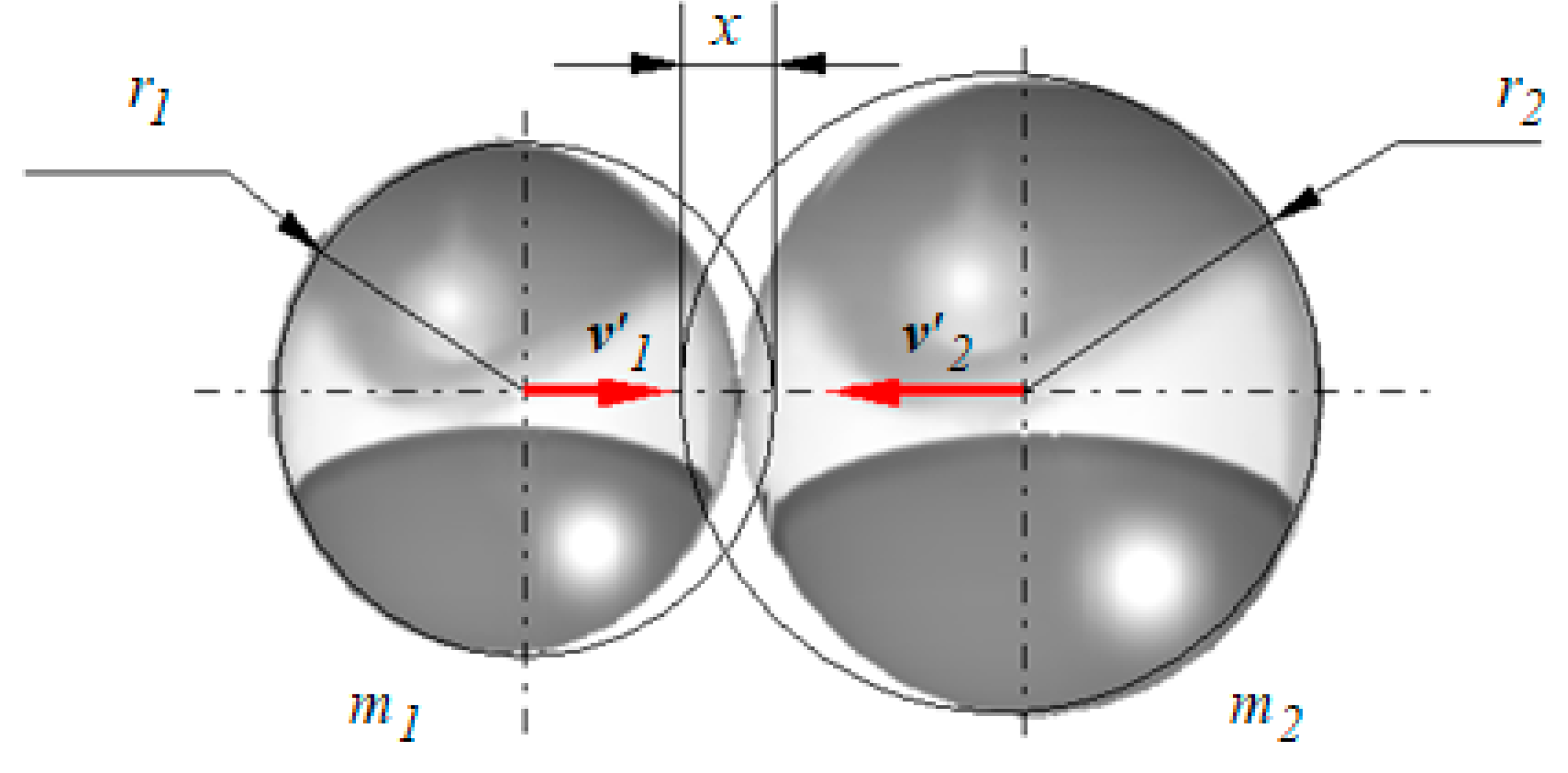
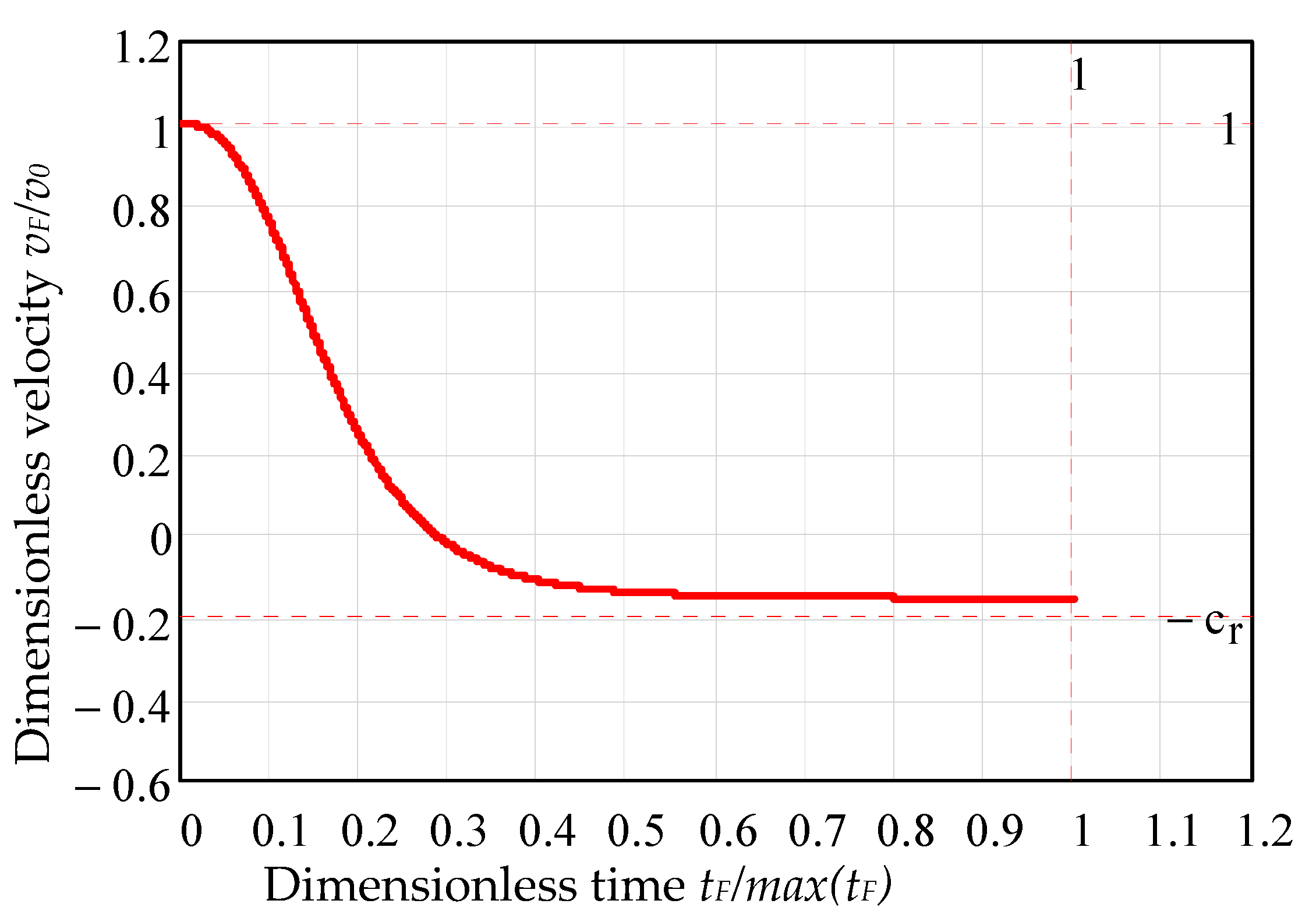
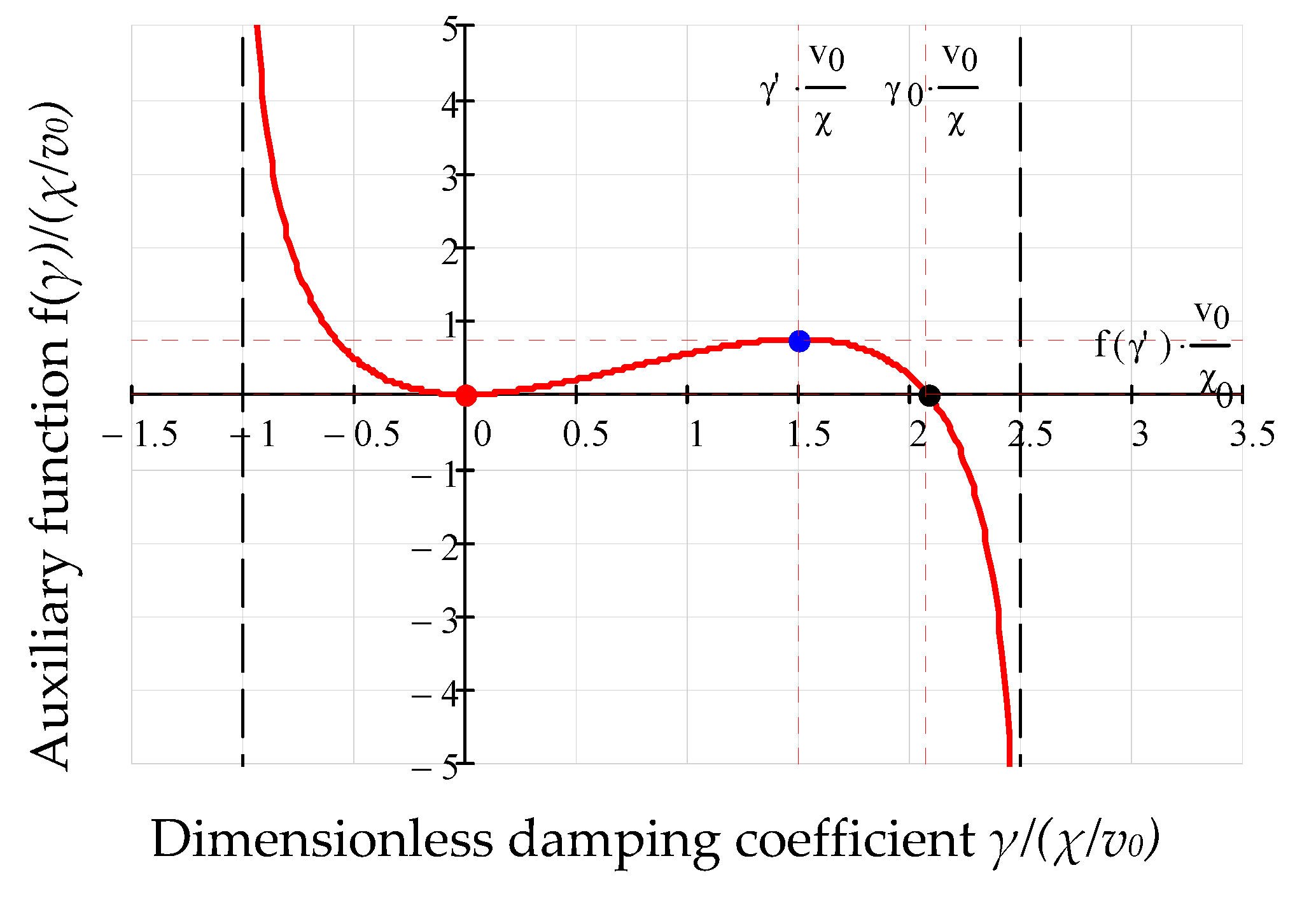
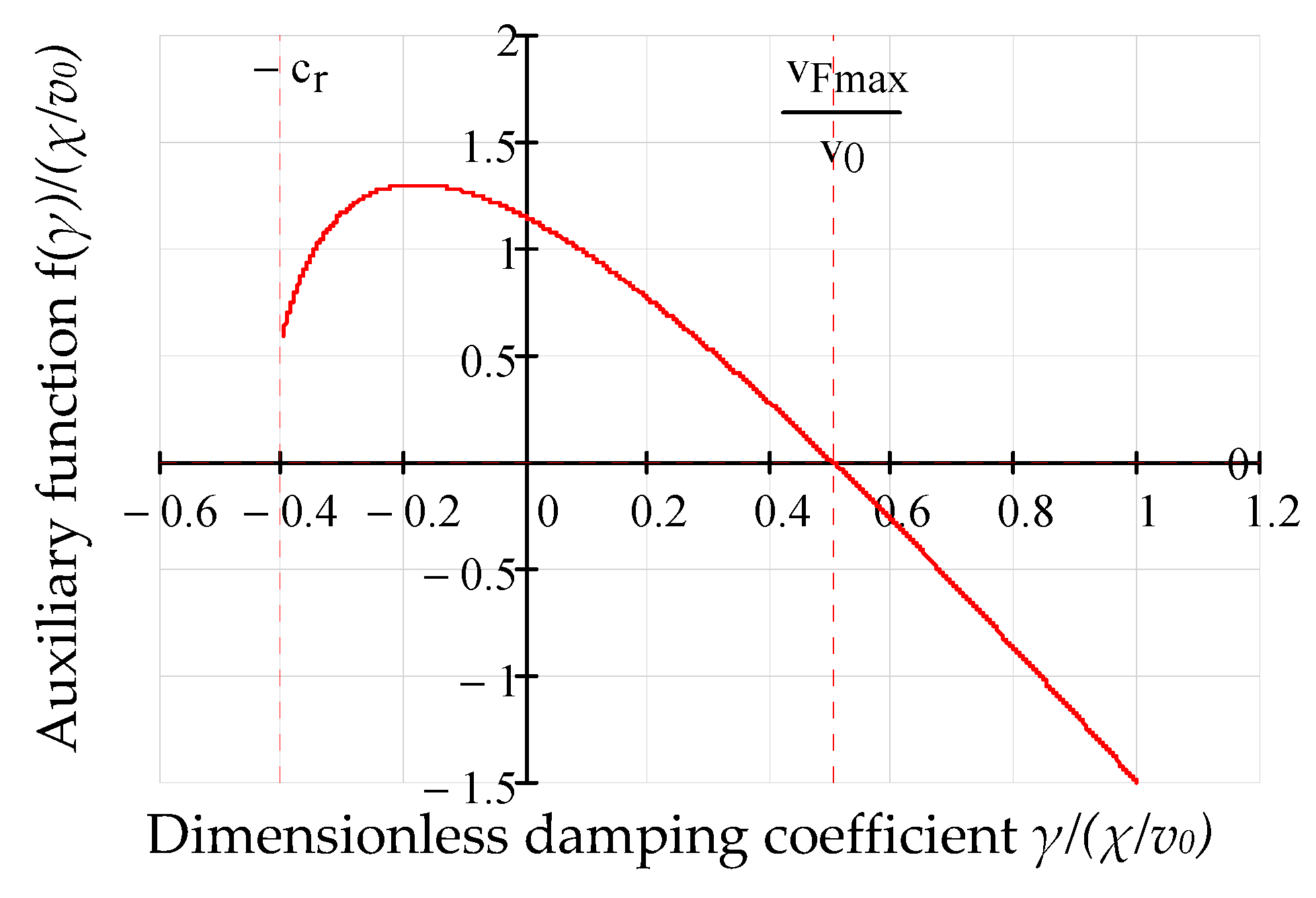



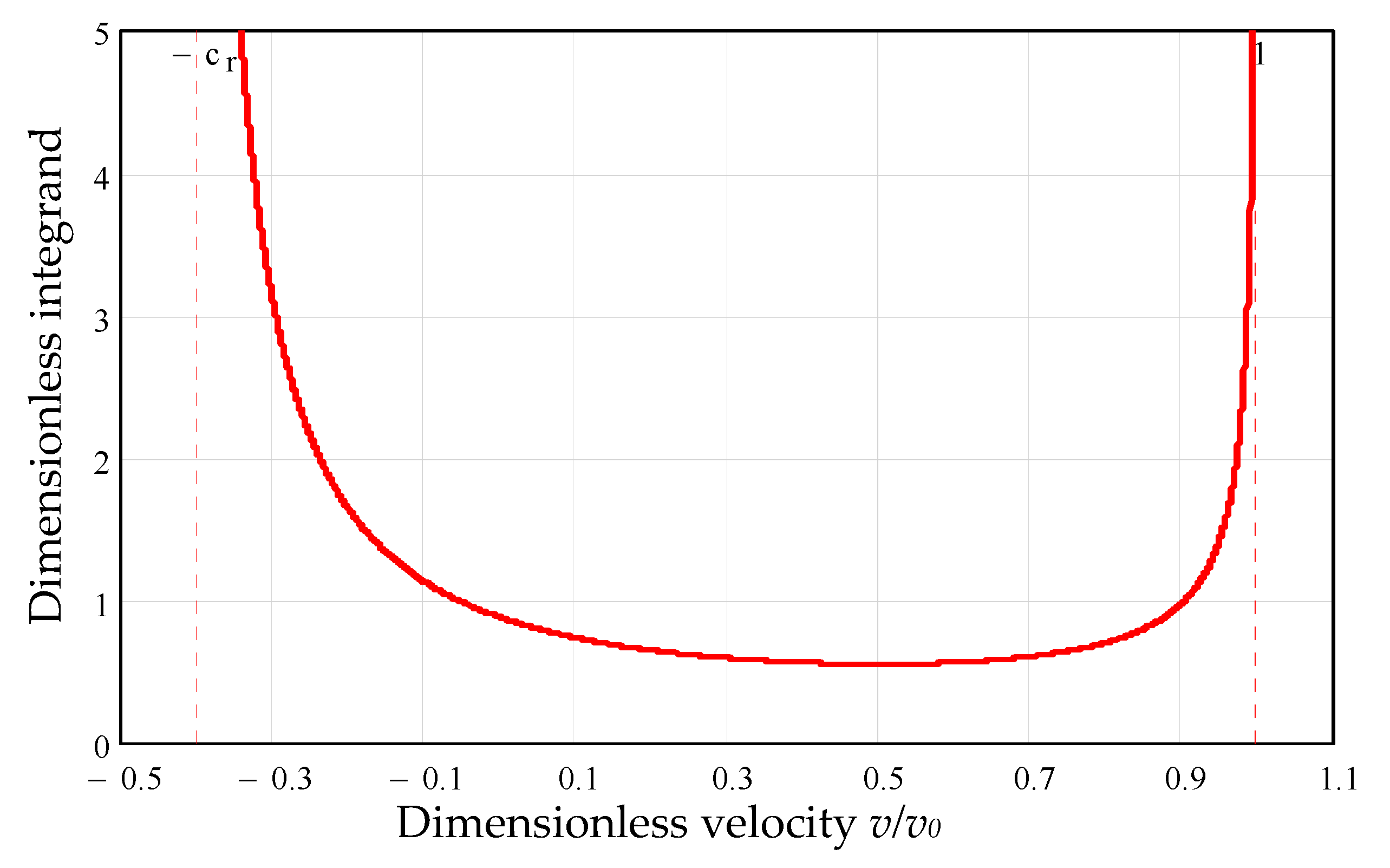
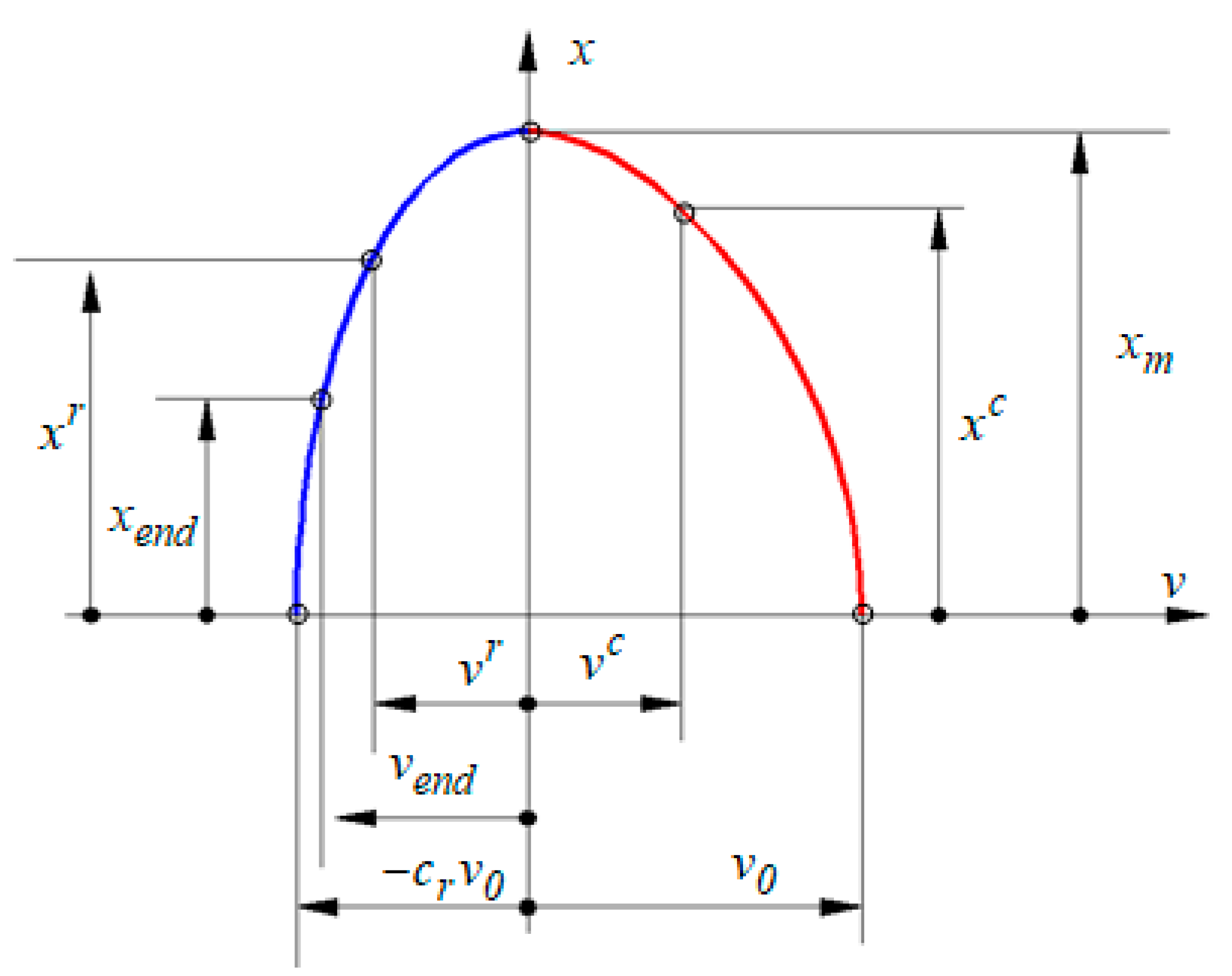
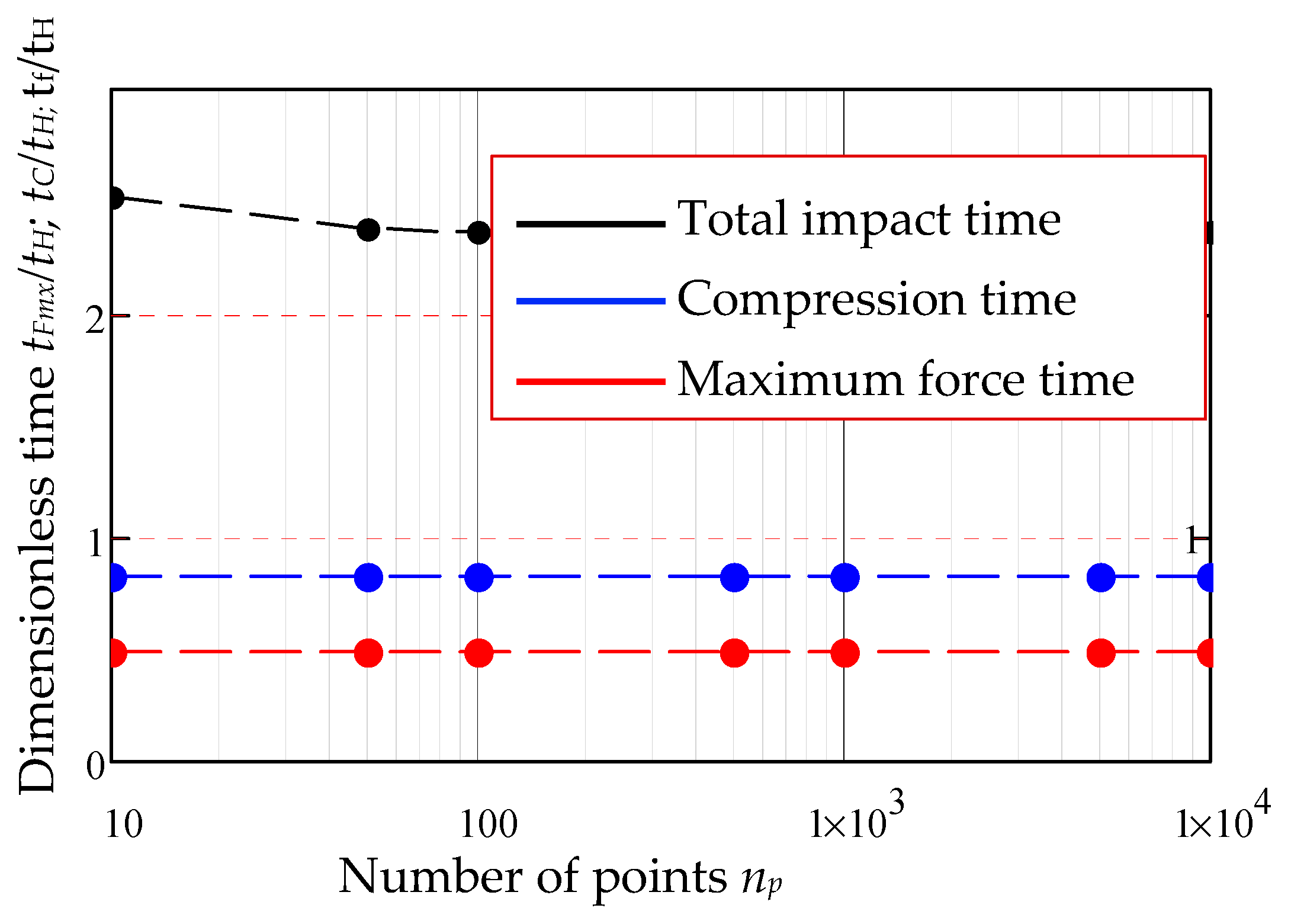
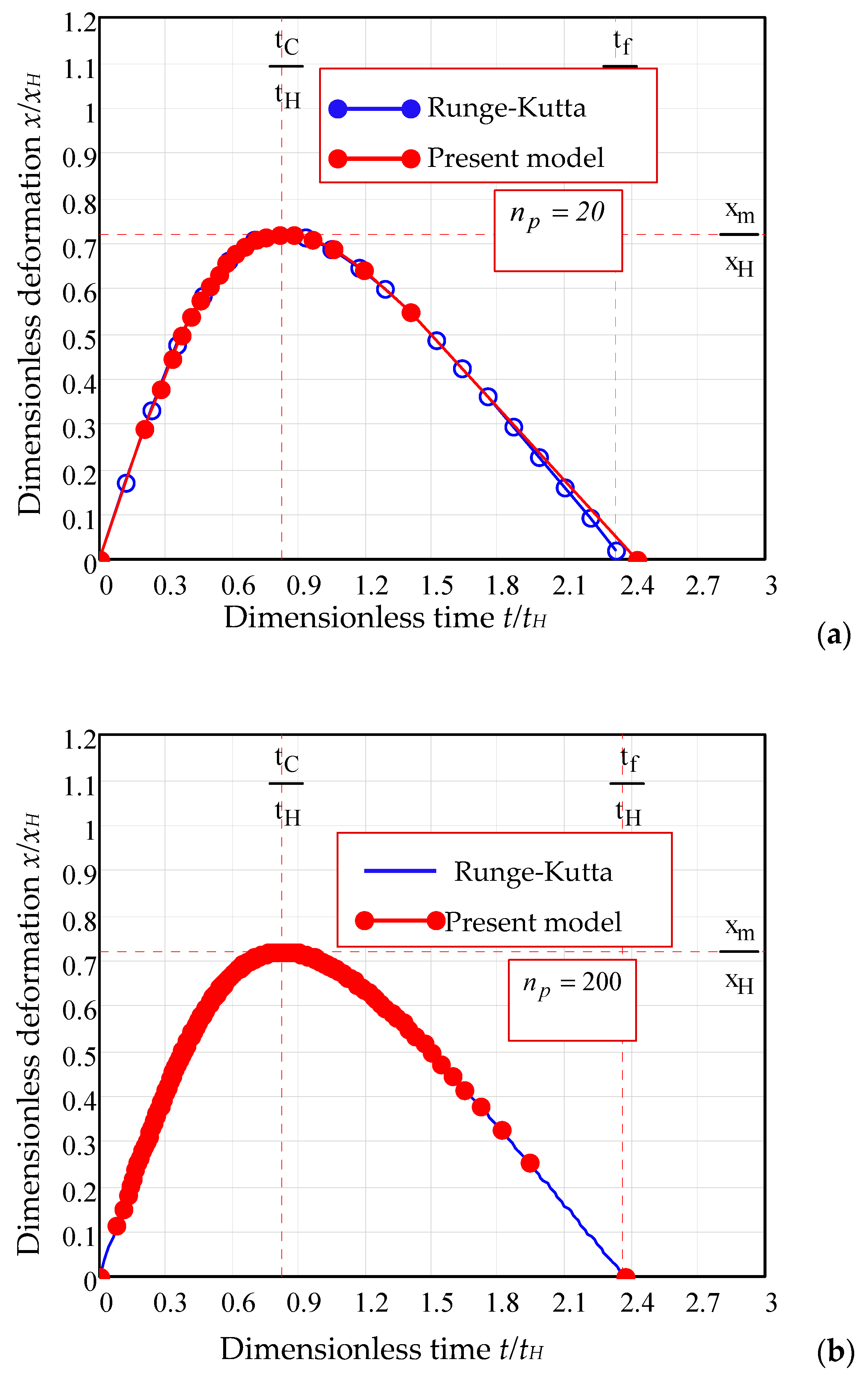

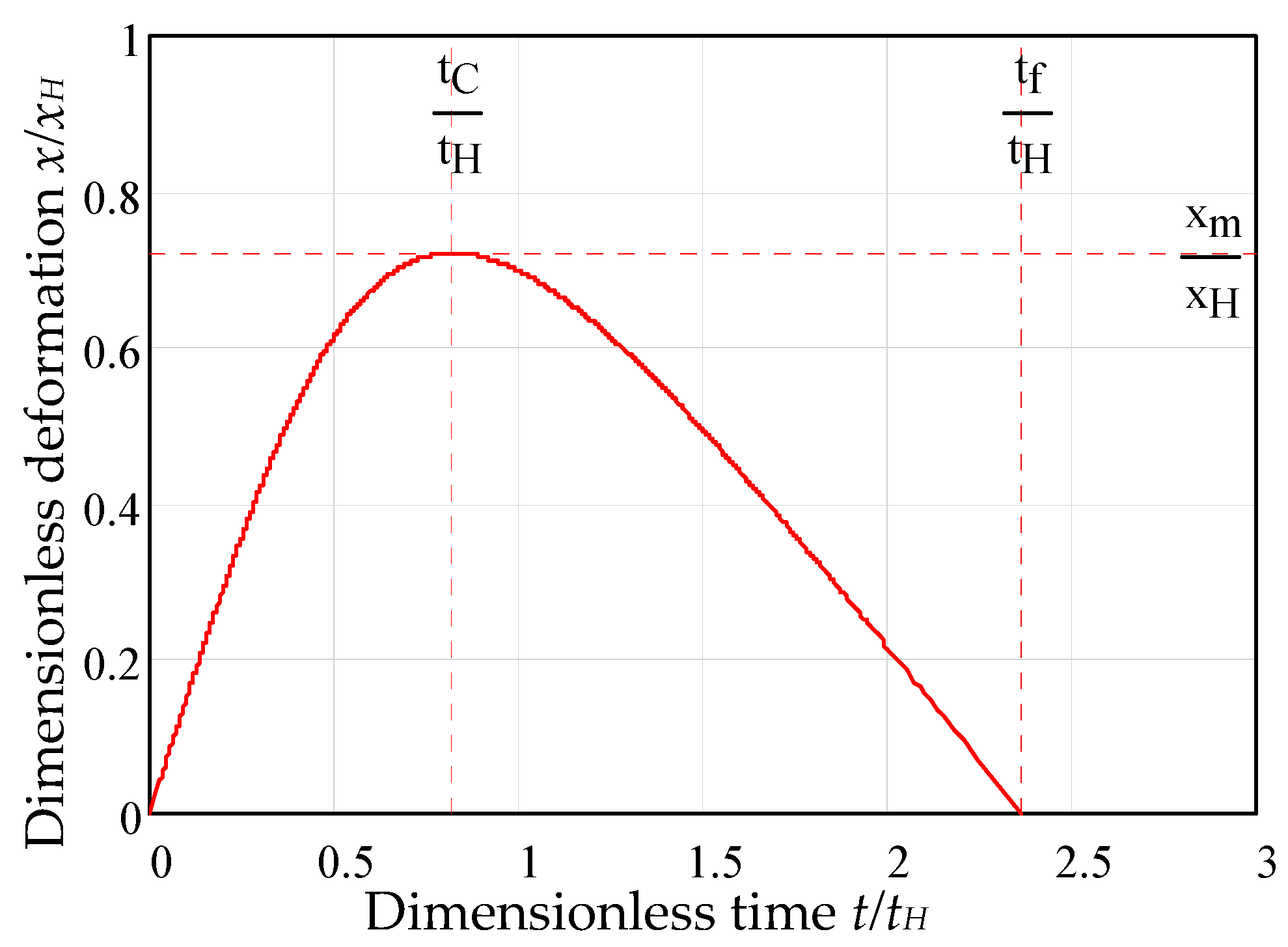
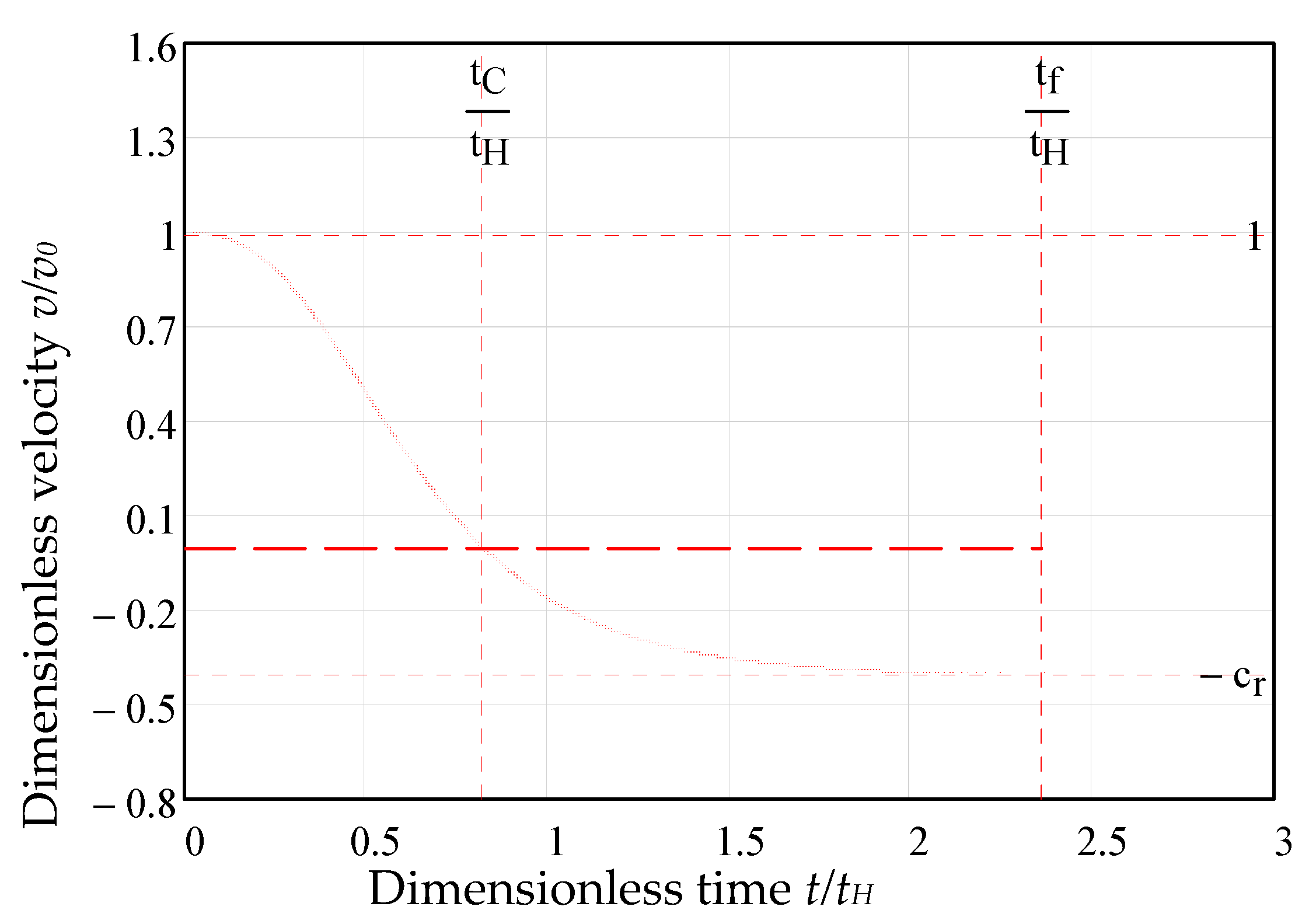
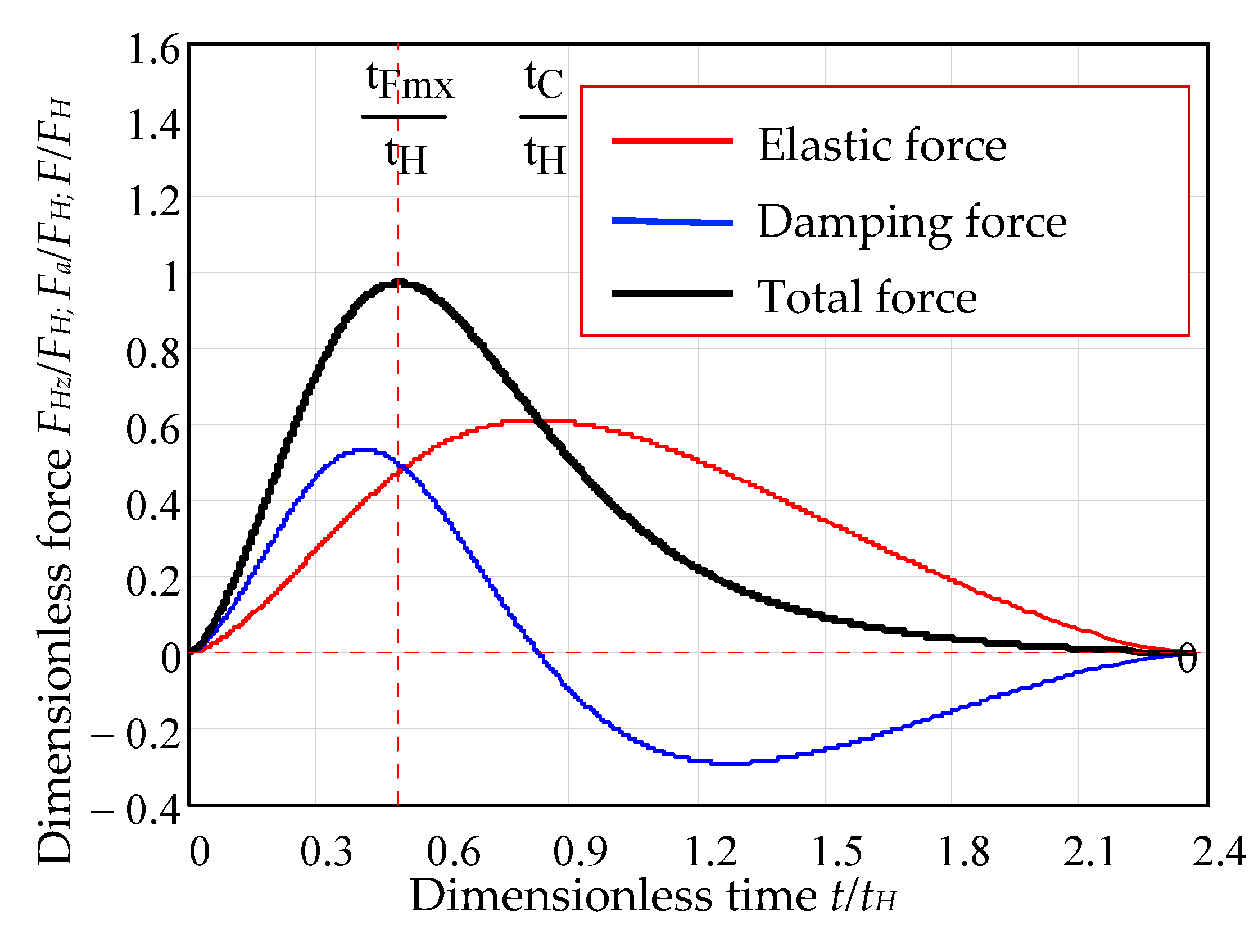





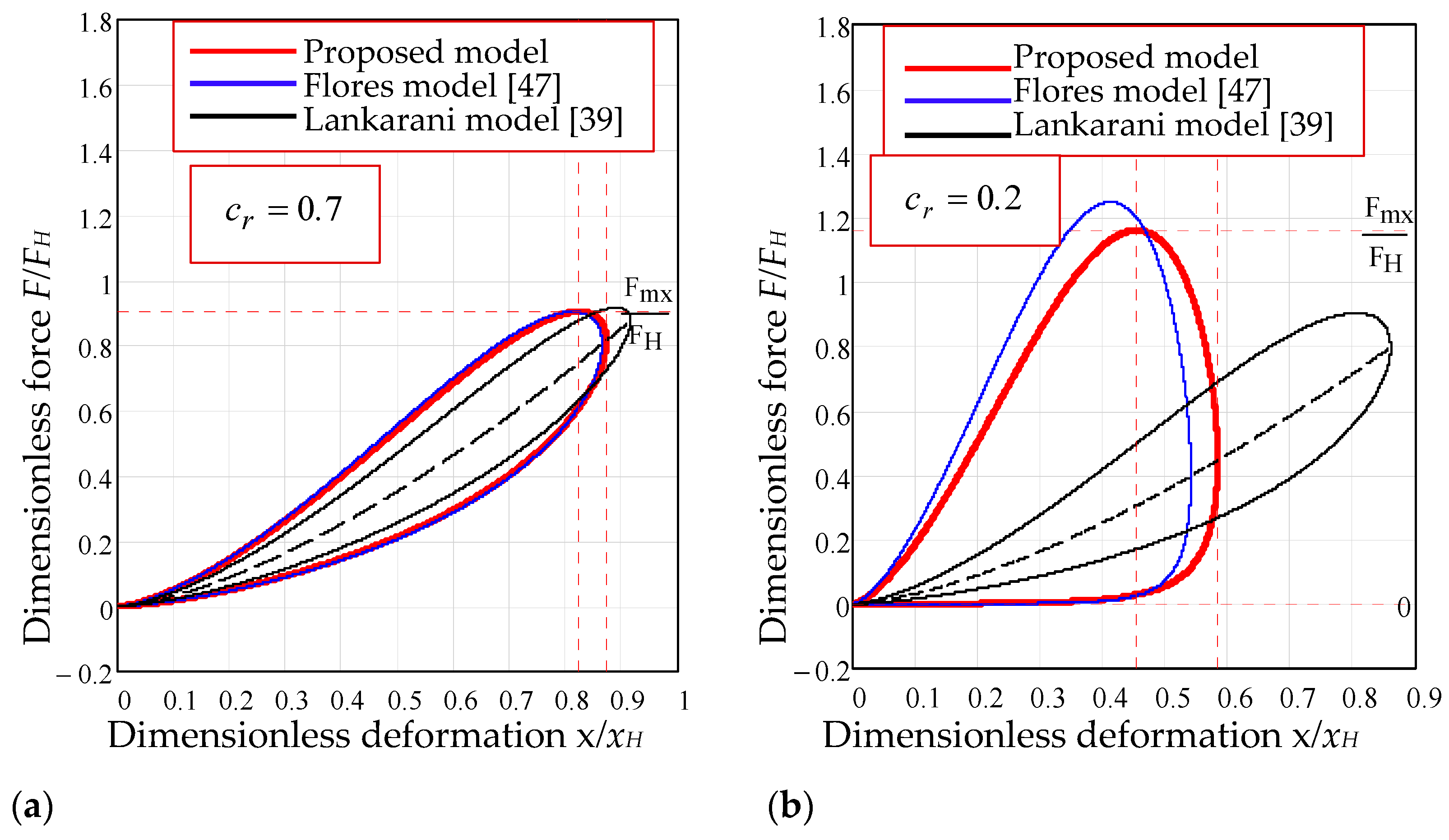
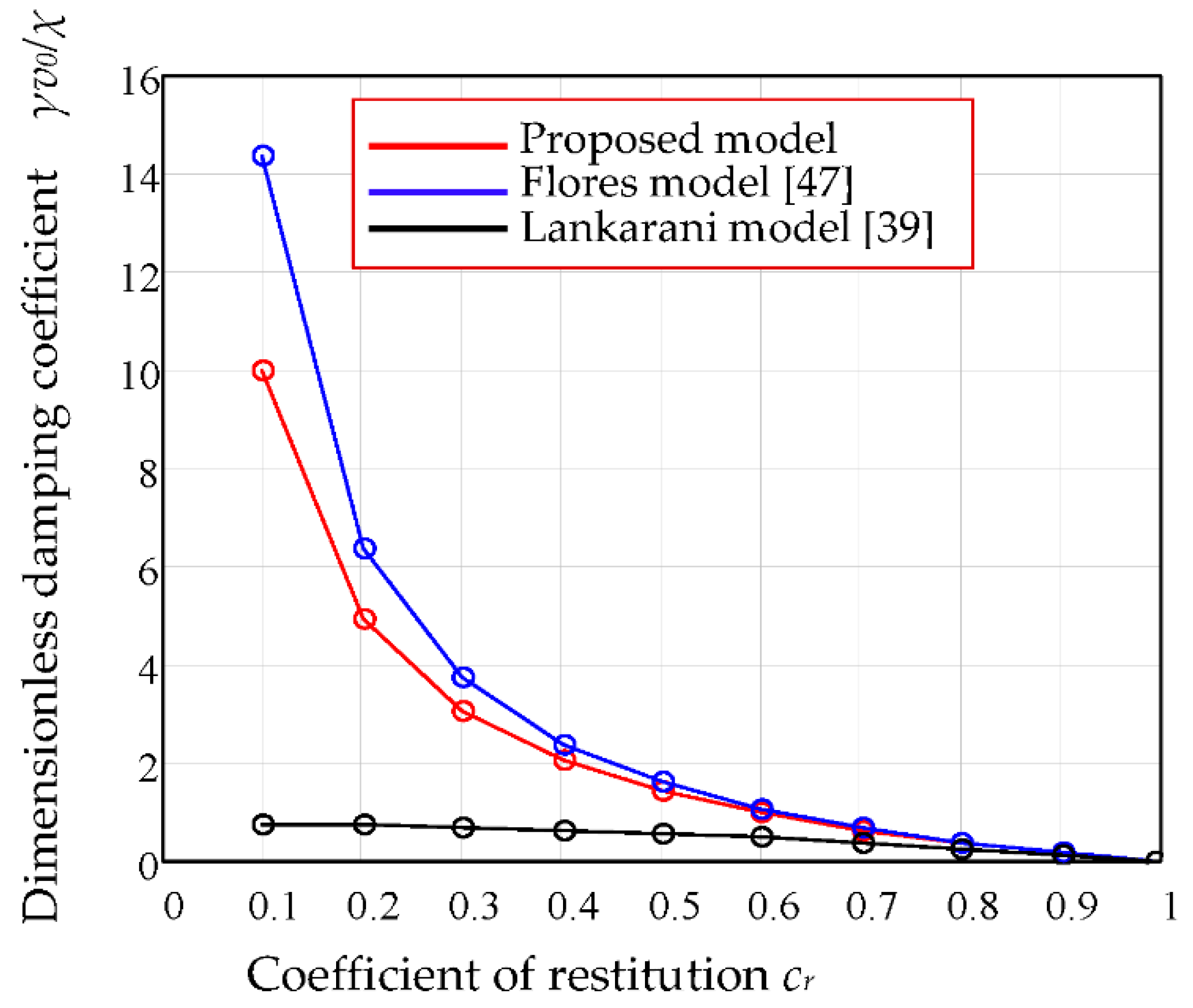

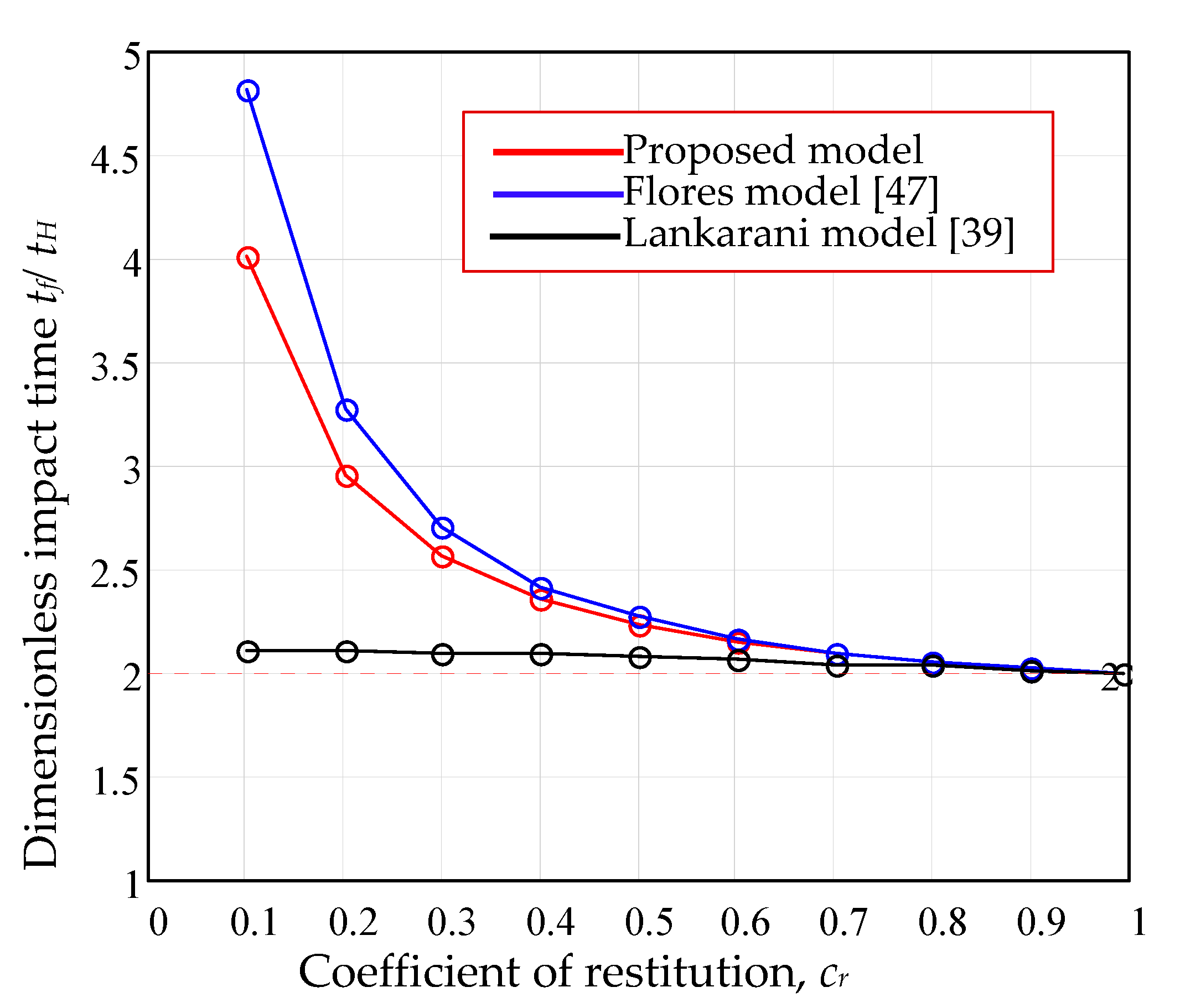
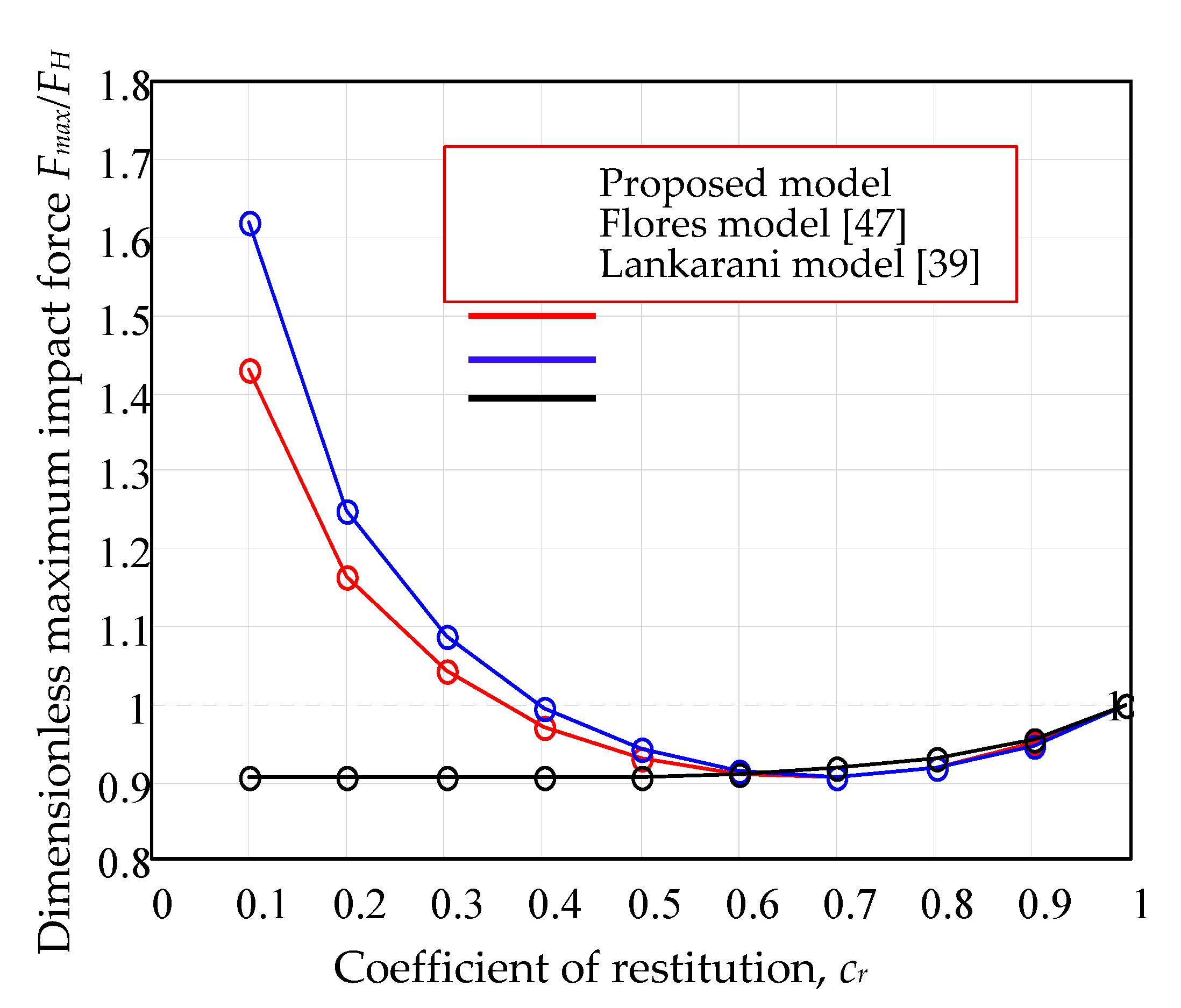
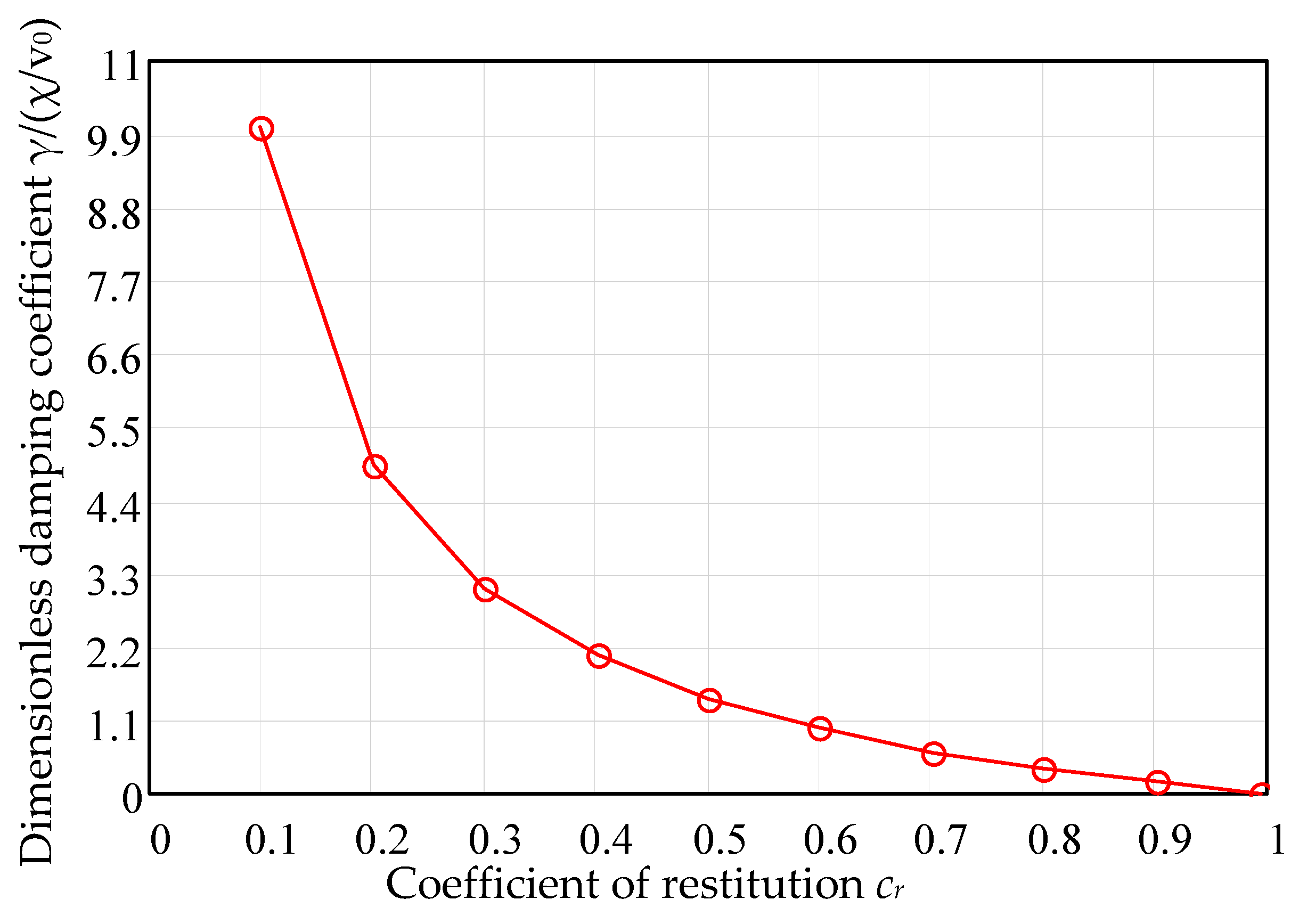
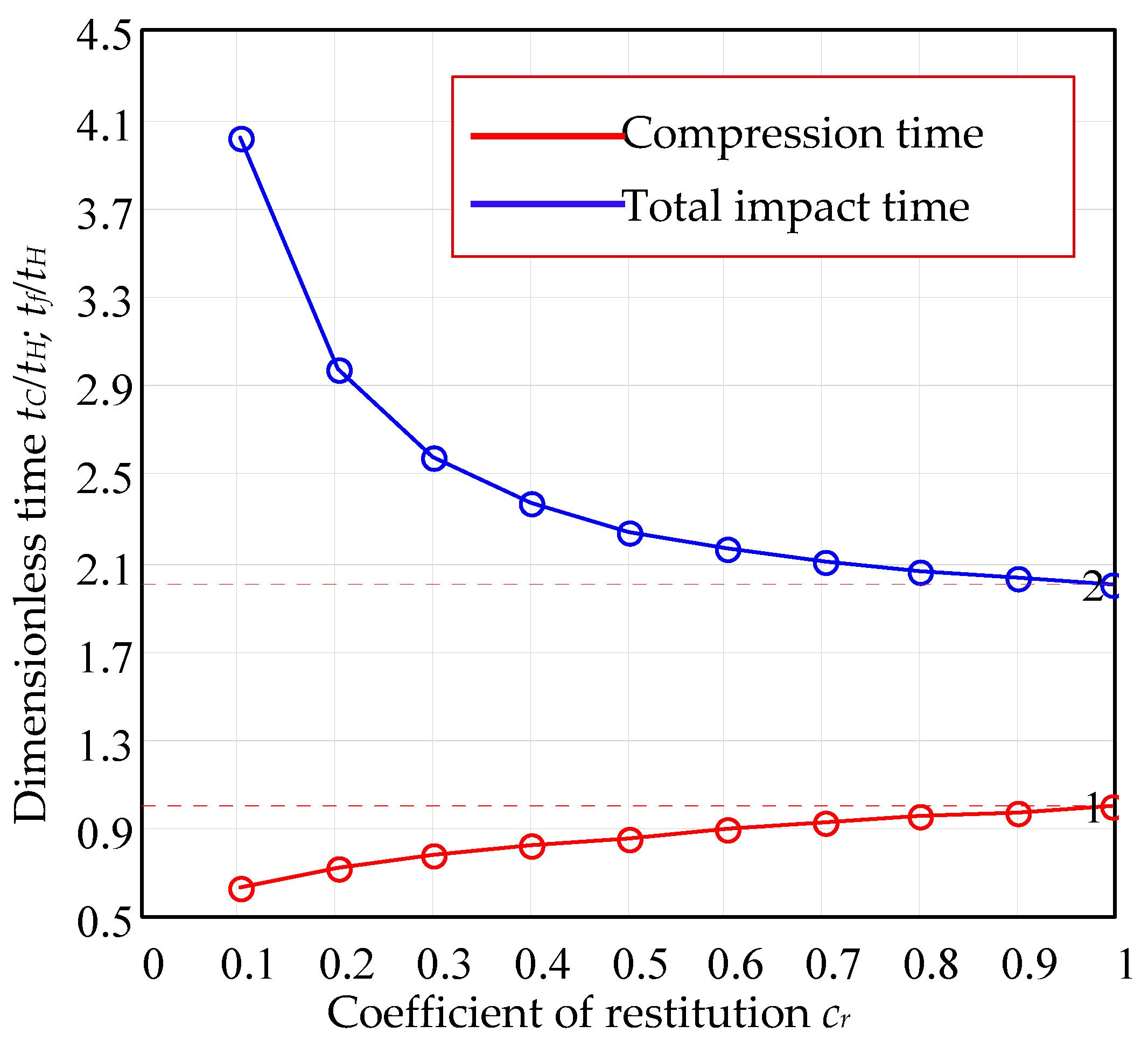
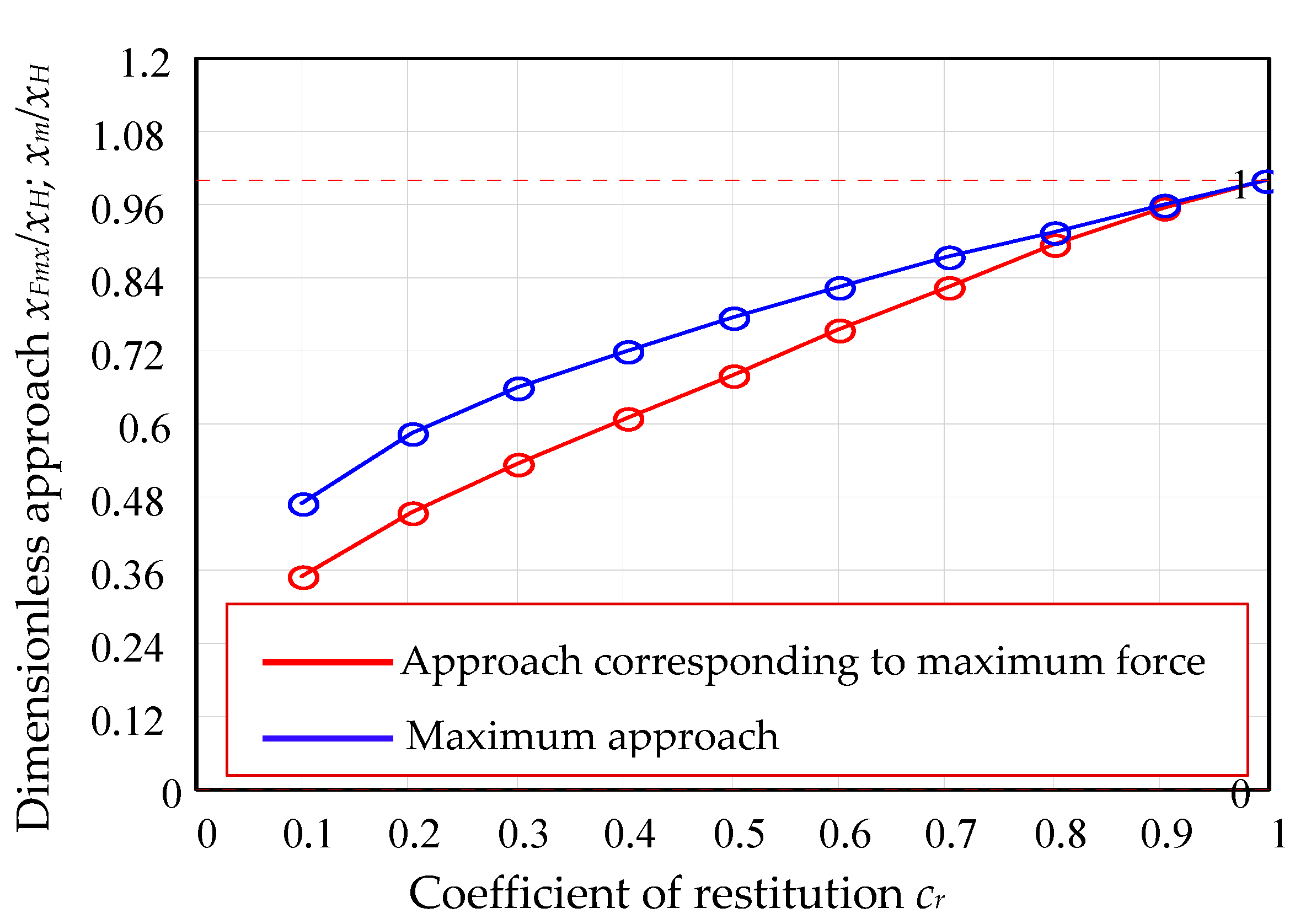

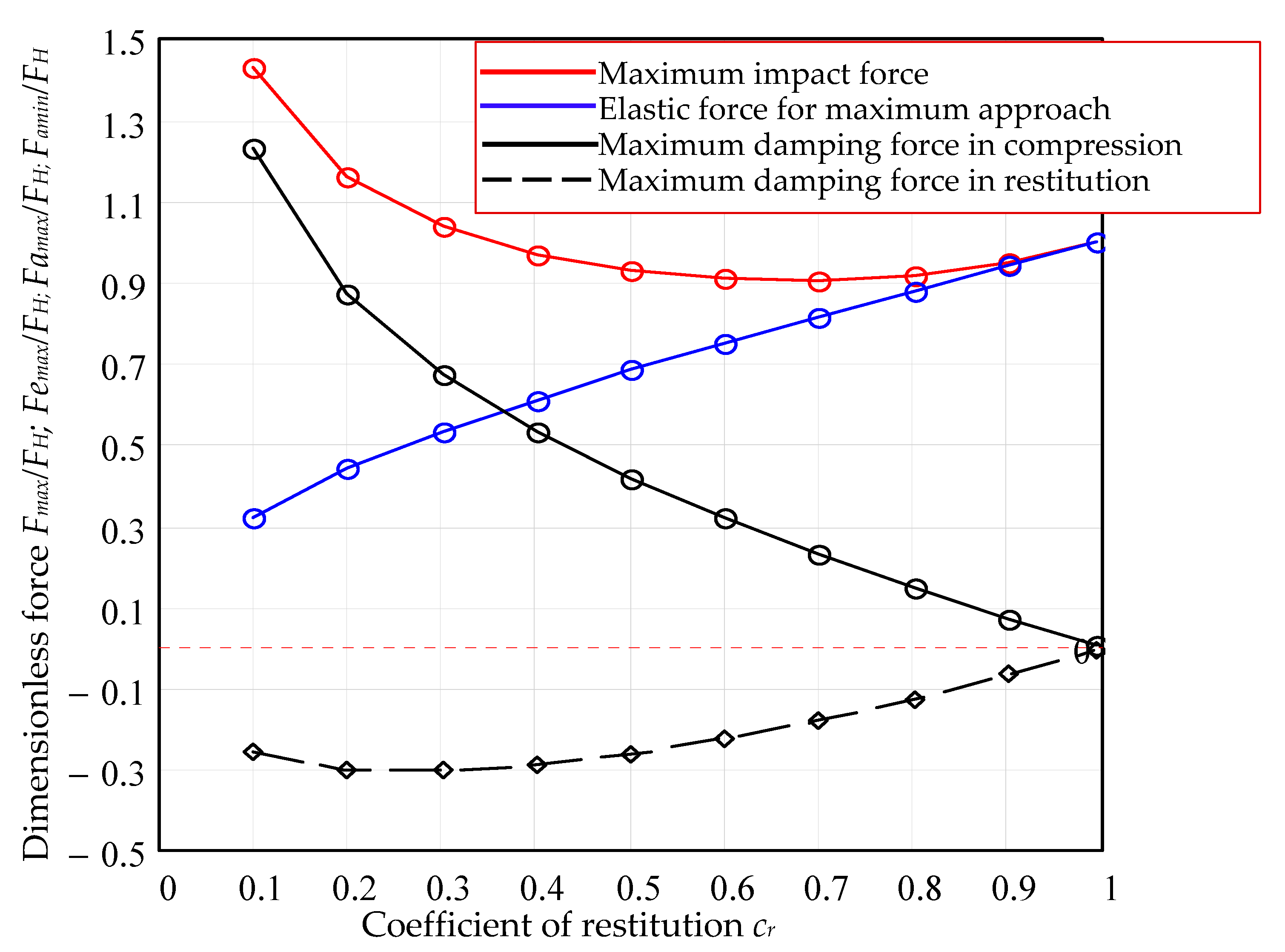

| 0.1 | 0.2 | 0.3 | 0.4 | 0.5 | 0.6 | 0.7 | 0.8 | 0.9 | 0.99 | |
|---|---|---|---|---|---|---|---|---|---|---|
| 9.998 | 4.919 | 3.087 | 2.082 | 1.433 | 0.975 | 0.635 | 0.373 | 0.166 | 0.008 | |
| 0.638 | 0.726 | 0.780 | 0.823 | 0.860 | 0.892 | 0.922 | 0.950 | 0.975 | 0.999 | |
| 4.015 | 2.965 | 2.572 | 2.366 | 2.240 | 2.156 | 2.097 | 2.055 | 2.023 | 2.001 | |
| 0.596 | 0.569 | 0.538 | 0.502 | 0.457 | 0.400 | 0.327 | 0.234 | 0.123 | 0.006 | |
| 0.348 | 0.454 | 0.535 | 0.609 | 0.681 | 0.753 | 0.824 | 0.893 | 0.953 | 0.998 | |
| 0.471 | 0.583 | 0.659 | 0.721 | 0.776 | 0.826 | 0.873 | 0.917 | 0.959 | 0.998 | |
| 1.431 | 1.161 | 1.041 | 0.971 | 0.930 | 0.908 | 0.904 | 0.917 | 0.949 | 0.997 | |
| 0.323 | 0.445 | 0.535 | 0.612 | 0.683 | 0.750 | 0.815 | 0.878 | 0.940 | 0.997 | |
| 1.231 | 0.869 | 0.674 | 0.533 | 0.419 | 0.319 | 0.230 | 0.148 | 0.072 | 0.004 | |
| 0.258 | 0.299 | 0.303 | 0.289 | 0.263 | 0.227 | 0.181 | 0.128 | 0.067 | 0.004 | |
| 0.849 | 0.741 | 0.649 | 0.560 | 0.471 | 0.381 | 0.289 | 0.195 | 0.099 | 0.005 | |
| 0.090 | 0.211 | 0.259 | 0.279 | 0.278 | 0.259 | 0.220 | 0.165 | 0.091 | 0.005 | |
| 0.152 | 0.260 | 0.352 | 0.441 | 0.530 | 0.619 | 0.711 | 0.805 | 0.901 | 0.995 | |
| 0.939 | 0.952 | 0.907 | 0.839 | 0.749 | 0.640 | 0.510 | 0.360 | 0.190 | 0.010 |
Publisher’s Note: MDPI stays neutral with regard to jurisdictional claims in published maps and institutional affiliations. |
© 2021 by the authors. Licensee MDPI, Basel, Switzerland. This article is an open access article distributed under the terms and conditions of the Creative Commons Attribution (CC BY) license (https://creativecommons.org/licenses/by/4.0/).
Share and Cite
Alaci, S.; Filote, C.; Ciornei, F.-C.; Grosu, O.V.; Raboaca, M.S. An Analytical Solution for Non-Linear Viscoelastic Impact. Mathematics 2021, 9, 1849. https://doi.org/10.3390/math9161849
Alaci S, Filote C, Ciornei F-C, Grosu OV, Raboaca MS. An Analytical Solution for Non-Linear Viscoelastic Impact. Mathematics. 2021; 9(16):1849. https://doi.org/10.3390/math9161849
Chicago/Turabian StyleAlaci, Stelian, Constantin Filote, Florina-Carmen Ciornei, Oana Vasilica Grosu, and Maria Simona Raboaca. 2021. "An Analytical Solution for Non-Linear Viscoelastic Impact" Mathematics 9, no. 16: 1849. https://doi.org/10.3390/math9161849






